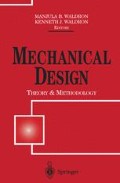Abstract
Collaborative design projects place additional burdens on design documentation practices. The literature on group design has repeatedly documented the existence of problems in design decision making due to the unavailability of design information. This paper describes a data representation developed for collaborative mechanical design information. The data representation is used to record the history of the design as a sequence of design decisions. The resulting database records the final specifications, the alternatives that were considered during the design process, and the designers’ rationale for choosing the final design parameters. It is currently implemented in a computerized data base system under development by the Design Process Research Group (DPRG), at the authors’ institution (Oregon State University).
Access this chapter
Tax calculation will be finalised at checkout
Purchases are for personal use only
Preview
Unable to display preview. Download preview PDF.
References
Chen, A., McGinnis, B., Ullman, D. G., and Dietterich, T. G. (1990). Design history knowledge representation and its basic implementation. Department of Mechanical Engineering, Oregon State University.
Conklin, J., and Begeman, M. (1988). gIBIS: A hypertext tool for exploratory policy discussion. Proceedings of the Conference on Computer Supported Cooperative Work,September 1988, ACM, pp. 140–152.
Curtis, B., Krasner, H., and Iscoe, N. (1988). A field study of the software design process for large systems. MCC Technical Report, Number STP-233–88.
Ellis, C. A., Gibbs, S. J., and Rein, G. L. (1988). The groupware project: An overview. MCC Technical Report, Number STP-033–88.
McCall, R. J. (1989). MIKROPLIS: A hypertext system for design. Design Studies, 10(4), 228–238.
McGinnis, B. D. (1990). An object orientated representation for mechanical design based on constraints. Master of Science Thesis, Department of Mechanical Engineering, Oregon State University.
Morjaria, M., Kelsch, R., and Draugelis, V. (1989). Computer-supported tools for collaborative engineering design. Design Institute, Xerox Corp.
Nagy, R. L. (1990). A knowledge base data representation for collaborative mechanical design. Master of Science Report, Department of Mechanical Engineering, Oregon State University.
Radcliffe, D., and Lee, T. Y. (1989). Design methods used by undergraduate engineering students. Design Studies, 10(4), 199–207.
Rittel, H. W. J., and Webber, M. M. (1973). Dilemmas in a general theory of planning. Policy Sciences, 4 155–169.
Smith R. G., Kleyn, M. F., and Schoen, E. (1988). Impulse reference guide. Research Note SYS-47–41, Schlumberger Technologies Corp.
Tang, J. C., and Leifer, L. J. (1988). A framework for understanding the workspace activity of design teams. System Sciences Laboratory Xerox Palo Alto Research Center, Center for Design Research Mechanical Engineering Dept., Stanford University.
Ullman, D. G. (1991). Mechanical Design Process. New York: McGraw Hill.
Ullman, D. G., Dietterich, T. G., and Stauffer, L. A. (1988). A model of the mechani- cal design process based on empirical data. Artificial Intelligence in Engineering, Design, and Manufacturing. 2 (1), 33–52.
Yakemovic, K. B., and Conklin, J. (1989). The capture of design rationale on an industrial development project: preliminary report. MCC Technical Report, Number STP-279–89, July 14, 1989.
Editor information
Editors and Affiliations
Rights and permissions
Copyright information
© 1996 Springer Science+Business Media New York
About this chapter
Cite this chapter
Nagy, R.L., Ullman, D.G., Dietterich, T.G. (1996). A Data Representation for Collaborative Mechanical Design. In: Waldron, M.B., Waldron, K.J. (eds) Mechanical Design: Theory and Methodology. Springer, New York, NY. https://doi.org/10.1007/978-1-4757-2561-2_11
Download citation
DOI: https://doi.org/10.1007/978-1-4757-2561-2_11
Publisher Name: Springer, New York, NY
Print ISBN: 978-1-4757-2563-6
Online ISBN: 978-1-4757-2561-2
eBook Packages: Springer Book Archive

